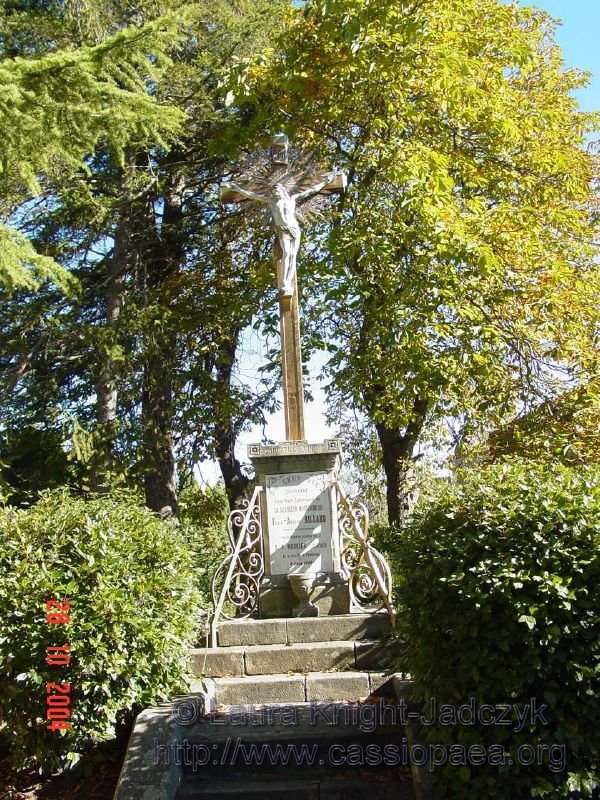The Quantum Future School Goes to Rennes-le-Chateau (20 of 68)
![[First]](bw_first.gif)
|
![[Prev]](bw_prev.gif)
|
![[Index]](bw_index.gif)
|
![[Next]](bw_next.gif)
|
![[Last]](bw_last.gif)
|

|
|
In Sauniere's garden is a statue erected to commemorate the visit of the Bishop of Carcassone, Mgr. Billard. Mgr. Billard had an affinity for very rich families, especially the older members of those families. He was brought to court by members of a family from Coursan for having coerced their matriarch into signing over all her belongings to the Bishop. She was declared of ‘Unsound’ mind. Curiously, Mgr. Billard arranged to have the will signed over to himself as Monsieur Billard, not Monseigneur (Mgr.) Billard. His Notary was from Rouen; where the actual execution of the will took place. (Jarnac, Archives, p. 464 to 468). Apparently, Billard conducted himself in this fashion with several families and their patrons. It is certainly not inconceivable that Billard may have shown Sauniere how to do this for himself, as well as others. One priest in particular accused the Bishop of Simony and having stolen over 1 Million Francs from the Diocese pension fund. After an investigation by the Vatican, it found that Billard had seriously mismanaged his diocese and was forced to give 200 000 francs to the monastery of Prouille. (Jarnac, Archives, p. 464) He passed away on December 3rd, 1901. Mgr Billard’s replacement, Paul-Felix Beauvain de Beausejour was named Bishop of Carcassonne on May 13th 1902. Mgr. Beausejour found a diocese that was close to ruin due to Mgr. Billard’s mismanagement. Mgr Billard had let subordinate priests administer their parishes as they saw fit as long as they stayed out of trouble and did not underme his authority. It was 4 years before the newly appointed Bishop asked Sauniere to explain his source of income. Apparently, several complaints had been lodged against Berenger Sauniere locally but their origins were never revealed; and some were simply inquiries into Sauniere’s character from other countries such as Italy, France, Belgium and Switzerland. (Jarnac, Histoire, p. 193) The Bishop’s first move was to transfer to Coustouge parish as of January 22nd, 1909. In retaliation, Beranger Sauniere tendered his resignation ten days later, on February 1st, 1909. The mayor of Rennes-le-Chateau complained to the Bishop in a letter dated February 6th, 1909, that Rennes-le-Ch?teau supported it’s priest, Berenger Sauniere, and that in the event the priest was moved, the villages of Esperaza and Rennes-le-Chateau would ‘’desert the Church,’’ (Jarnac, Histoire, p. 194) Sauniere’s replacement would be met with empty seats. The Mayor also mentioned to the Bishop that the Presbytery had been leased for another 5 years therefore, his replacement would have to seek shelter elsewhere. He could not refuse the new priest but he could make it so that the outsider would not have an easy time of it. (Jarnac, Histoire, p. 196)
|
![[First]](bw_first.gif)
|
![[Prev]](bw_prev.gif)
|
![[Index]](bw_index.gif)
|
![[Next]](bw_next.gif)
|
![[Last]](bw_last.gif)
|